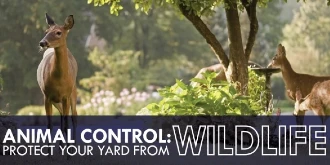The Grounds Guys offer expert tips to protect your yard from wildlife damage.
|
A beautiful yard that beckons birds and butterflies may also have an invisible "Welcome to the Diner" sign that invites nuisance wildlife to feast on your backyard buffet of plants. Flowers and even foliage plants, such as hostas, are irresistible to cute critters that become anything but cute after you survey the damage they cause. At first glance, some of these visitors may appear harmless, but even the tiny ones can cause big damage to your plants.

So what's a gardener to do to protect a garden against damage from these pests? The Grounds Guys® can help you with a strategy for wildlife control. We can move you toward the goal of keeping the invited visitors in your garden while putting out the "un"welcome mat for the undesirables.
Here's a list of common wildlife pests with tips to help protect your yard and garden from the damage they cause:
Squirrels and Chipmunks
Wildlife control for these creatures includes not only mitigating garden damage but also preventing damage to your home's structure. Squirrels may chew on siding or eaves to gain entry to your home's attic -- and chipmunks into your crawl space -- where they make nests. Once inside, they may chew on insulation and wiring. Squirrels and chipmunks raid bird feeders and steal the food you've earmarked for your backyard birds.
Wildlife control strategies:
- Eliminate their food sources. Use feeders that have protective baffles, cages or weighted hoppers that allow birds in but keep squirrels and chipmunks out.
- Prune tree limbs. To keep squirrels at a jumping distance away from your house or bird feeders, trim tree limbs and shrubs at least 10 feet away from these structures. The Grounds Guys are trained in proper pruning methods that leave your plants healthy and well-shaped.
- Exclude them. Seal holes, even tiny ones, where HVAC and gas lines, dryer vents, cable television and satellite cables enter your house.
- Cover downspouts. Chipmunks are particularly bothersome to clog downspouts with bedding material, which can cause water damage. Install wire-mesh downspout covers and clean them regularly.
Rabbits
Adorable little bunny rabbits can chew your plants down to not-so-adorable nubs. They'll eat flowers, herbs and vegetables in the spring and summer and branches, stems and buds from your shrubs in the winter. If you have a strawberry bed, it's particularly appealing to rabbits.
Wildlife control strategies:
- Fencing. You may need to install chicken wire around certain crops, such as strawberries, to keep the rabbits out. Make sure the wire is at least two-feet high after burying it a few inches into the ground.
- Tree cylinders. Place hardware-cloth cylinders several inches from the trunks of trees and landscape shrubs and at least two-feet high.
- Taste/Odor repellents. Commercially available repellents that are distasteful to rabbits can help protect your plants. You'll need to re-apply the products periodically, particularly after it rains.
Raccoons, Skunks and Opossums
You may never see these creatures because their damage typically occurs at night. These nocturnal creatures are notorious for raiding garbage cans and leaving trash strewn in your yard.
Wildlife control strategies:
- Suitable containers and lids. Use tight-fitting, weighted or clamped lids on garbage receptacles that can't be tipped over.
- Humane trapping. If these creatures cause ongoing and extensive damage, you may need to use a humane catch-and-release trap.
Moles, Voles and Shrews
What's the difference in identification and wildlife control of each?
- Moles are up to six inches in length with no external ears and eyes that are concealed in their fur. They make tunnels in your yard as they feed on insects, grubs and earthworms. Mole repellents may have limited effectiveness, and if their damage is extensive, you may consider trapping them.
- Voles are rodents, which are approximately the same size as moles but with large eyes, small ears and blunt snouts. They eat plants, seeds and bulbs. Bury hardware cloth in the ground around flower beds or use the same exclusion strategies for rabbits. Keep compost in covered bins instead of in open areas.
- Shrews are smaller -- only three or four inches long -- with eyes and ears that are hidden in their fur and long, pointed snouts. Although their primary diet is insects, they may also eat stored bird seed and attack birds at feeders. Use squirrel-proof feeders and cover stored bird seed.
Protecting your yard and garden from damage is one facet of a comprehensive landscape maintenance program. Call on The Grounds Guys with any wildlife control question you have. We'll help protect your garden while we maintain it.